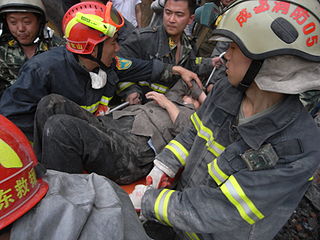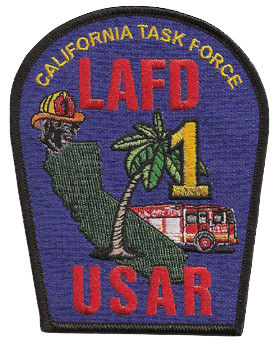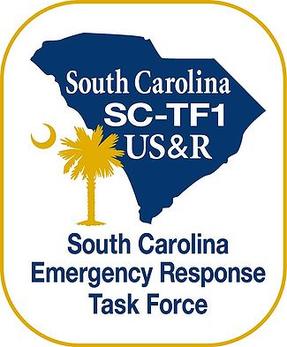
Urban search and rescue is a type of technical rescue operation that involves the location, extrication, and initial medical stabilization of victims trapped in an urban area, namely structural collapse due to natural disasters, war, terrorism or accidents, mines and collapsed trenches.

The Miami-Dade Fire Rescue Department (MDFR) provides fire protection and emergency medical services to the unincorporated parts of Miami-Dade County, Florida, along with 30 municipalities located within the county. In all the department is responsible for 1,883 square miles (4,880 km2) of land.

The Miami Fire-Rescue Department, also referred to as the City of Miami Department of Fire-Rescue, provides fire protection and emergency medical services for the city of Miami, Florida. The department is notable for being the first in the nation to equip all apparatus with two-way radios, as well as being the first to use fog nozzles.

Urban Search and Rescue California Task Force 1 or CA-TF1 is a FEMA Urban Search and Rescue Task Force based in Los Angeles, California and sponsored by the Los Angeles Fire Department.

Urban Search and Rescue California Task Force 2 or CA-TF2 is a FEMA Urban Search and Rescue Task Force based in Los Angeles County, California. CA-TF2 is sponsored by the Los Angeles County Fire Department.
Urban Search and Rescue California Task Force 4 or CA-TF4 is a FEMA Urban Search and Rescue Task Force based in Oakland, California. CA-TF4 is sponsored by the Oakland Fire Department.

Urban Search and Rescue California Task Force 5 or CA-TF5 is a FEMA Urban Search and Rescue Task Force based in Orange County, California. CA-TF5 is sponsored by the Orange County Fire Authority.

Urban Search and Rescue Colorado Task Force 1 (CO-TF1) is a FEMA Urban Search and Rescue Task Force based in Colorado. They were one of the 20 FEMA Urban Search and Rescue Task Force teams deployed to the World Trade Center site after the September 11, 2001 attacks. The task force is sponsored by the West Metro Fire Protection District and is made up of 70 positions with over 200 trained members including firefighters, paramedics, engineers and canine handlers.
Urban Search and Rescue Florida Task Force 1 (FL-TF1) is a FEMA Urban Search and Rescue Task Force based in Miami-Dade County, Florida and sponsored by the Miami-Dade Fire Rescue Department. The mission of FL-TF1 is to respond to natural and man-made disasters to provide search and rescue as well as both medical and communications support.

Urban Search and Rescue Florida Task Force 2 or FL-TF2 is a FEMA Urban Search and Rescue Task Force based in Miami, Florida and sponsored by the Miami Fire Department. FL-TF2 was started in 1991 and is designed to respond to a variety of disasters, including earthquakes, hurricanes, and terrorist attacks. The Miami Fire Department sponsors the team, and provides administrative staff as well as warehouse space and other infrastructure needs. The team is composed of experts from 23 additional fire and police departments as well as civilians making up the 210 members of the team.

Urban Search and Rescue Missouri Task Force 1 (MO-TF1) is a FEMA Urban Search and Rescue Task Force based in Boone County, Missouri. The task force is sponsored by the Boone County Fire Protection District and is designated as the Weapons of Mass Destruction (WMD) Response Team for the state of Missouri.
Urban Search and Rescue Nevada Task Force 1 or NV-TF1 is a FEMA Urban Search and Rescue Task Force based in Clark County, Nevada. The task force is sponsored by the Clark County Fire Department but also has members from the Las Vegas Fire & Rescue, Henderson Fire Department, North Las Vegas Fire Department and the Las Vegas Metropolitan Police Department.
Urban Search and Rescue Pennsylvania Task Force or PA-TF1 is a FEMA Urban Search and Rescue Task Force based in the Commonwealth of Pennsylvania.

Texas A&M Task Force 1, abbreviated TX-TF1, is a FEMA Urban Search and Rescue Task Force, one of 28 teams that form the FEMA National Urban Search and Rescue System, and as such it is in rotation for deploying to national disasters and incidents of national significance. It is sponsored by the Texas A&M Engineering Extension Service and headquartered in College Station, Texas.

Urban Search and Rescue Utah Task Force 1 is one of 28 Federal Emergency Management Agency (FEMA) Urban Search & Rescue Task Forces in the United States. The task force is based in Salt Lake City, Utah and is managed by the Unified Fire Authority. Activation of the task force is accomplished by the State of Utah, or FEMA for rapid deployment of the Task Force, modular or single US&R resources. The task force is self-sufficient for up to 72 hours and includes physicians, search dogs, heavy rescue technicians firefighters and paramedics, and structural engineers. The Task Force manages 6.3 million dollars in specialized vehicles and equipment that is maintained by personnel trained by FEMA.

Urban Search and Rescue Virginia Task Force 1 or VA-TF1 is a FEMA Urban Search and Rescue Task Force based in Fairfax County, Virginia. VA-TF1 is sponsored by the Fairfax County Fire and Rescue Department.
Urban Search and Rescue Virginia Task Force 2 (VA-TF2) is one of the 28 FEMA Urban Search and Rescue Task Forces. Based in Virginia Beach, VA-TF2 is sponsored by the Virginia Beach Fire Department.

Urban Search and Rescue South Carolina Task Force 1 or SC-TF1 is an urban search and rescue task force that is sponsored by the South Carolina Firefighter Mobilization Committee, which was created by the South Carolina Firefighter Mobilization Act of 2000.

The Phoenix Fire Department provides fire protection and emergency medical services for the city of Phoenix, Arizona. The department responded to 186,594 calls during 2014–2015, with 88% being for emergency medical services. The Phoenix Fire Department currently protects 1.5 million residents spread across an area of 520 square miles (1,300 km2).
Texas Task Force 2, abbreviated TX-TF2, functions as one of two state urban search and rescue (US&R) teams in the State of Texas. It is managed by the Texas A&M Engineering Extension Service and headquartered in Dallas, Texas.















